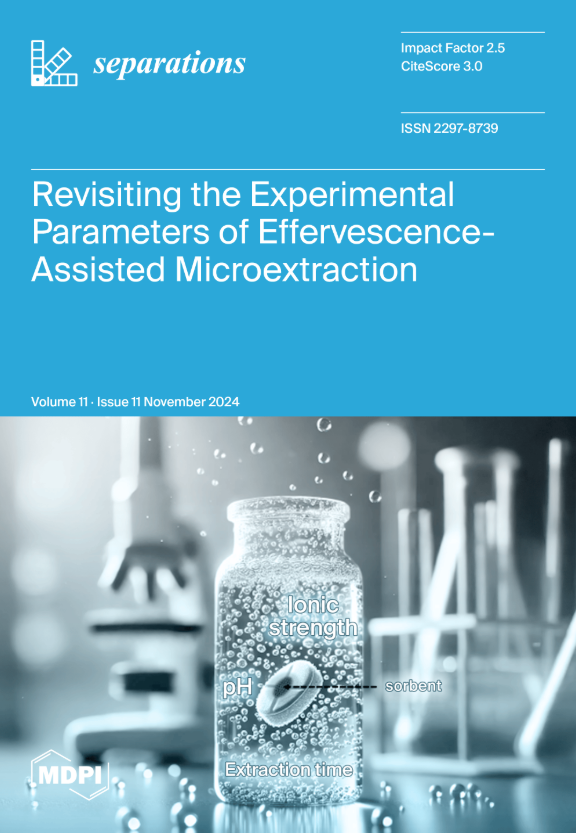不同产地艾草精油挥发性成分及抑菌活性的电子鼻-气相色谱-质谱分析
IF 2.7
4区 工程技术
Q3 CHEMISTRY, ANALYTICAL
引用次数: 0
摘要
采用电子鼻(E-nose)联合气相色谱-质谱(GC-MS)技术对不同产地的艾草挥发油进行挥发性成分分析,并对其精油的抑菌活性进行研究,为艾草的质量控制及艾草精油的合理利用提供科学依据。本研究采用水蒸气蒸馏法测定了艾草中总精油的含量;采用电子鼻法结合化学计量学对挥发性成分进行全面分析;采用GC-MS对挥发性成分进行分析鉴定;以2株g阴性菌和1株革兰氏阳性菌为试验菌,测定艾草精油的抑菌活性。结果表明,主成分分析(PCA)和线性判别分析(LDA)均能区分不同产地艾草精油,且精油气味差异明显。GC-MS共鉴定出87种挥发性成分,不同产地艾草的挥发性成分和含量存在显著差异;主成分分析和层次聚类分析(HCA)能有效区分不同产地的艾草。不同产地的艾草精油对枯草芽孢杆菌、金黄色葡萄球菌和大肠杆菌均有一定的抑制作用。因此,电子鼻与GC-MS相结合可以快速区分不同产地的艾草,为艾草的质量控制、药物选择和综合利用提供参考。本文章由计算机程序翻译,如有差异,请以英文原文为准。
Analysis of Volatile Components and Antibacterial Activity of Silver Wormwood Essential Oils from Different Habitats by E-Nose Combined with GC-MS
Electronic nose (E-nose) combined with gas chromatography–mass spectrometry (GC-MS) was used to analyze the volatile components of silver wormwood from different habitats, and the antibacterial activity of essential oils was also studied, to provide a scientific basis for quality control of silver wormwood and rational utilization of their essential oils. In this study, the total content of essential oils in silver wormwood was determined by steam distillation; the volatile components were conducted in an overall analysis by E-nose combined with chemometrics; the volatile components were analyzed and identified by GC-MS; and two G-negative bacteria and one Gram-positive bacteria were used as test bacteria to determine the antibacterial activity of the essential oils from silver wormwood. The results showed that principal component analysis (PCA) and linear discriminant analysis (LDA) of E-nose could distinguish the essential oils of silver wormwood from different habitats, and the odor difference of essential oils was obvious. A total of 87 volatile components were identified by GC-MS, and there were significant differences in components and contents in silver wormwood from different habitats; PCA and hierarchical cluster analysis (HCA) could effectively distinguish silver wormwood from different habitats. The essential oils from silver wormwood from different habitats all had a certain inhibitory effect on Bacillus subtilis, Staphylococcus aureus, and Escherichia coli. Therefore, the combination of E-nose and GC-MS could quickly distinguish silver wormwood from different habitats and provide a reference for quality control, drug selection, and comprehensive utilization of silver wormwood.
求助全文
通过发布文献求助,成功后即可免费获取论文全文。
去求助
来源期刊

Separations
Chemistry-Analytical Chemistry
CiteScore
3.00
自引率
15.40%
发文量
342
审稿时长
12 weeks
期刊介绍:
Separations (formerly Chromatography, ISSN 2227-9075, CODEN: CHROBV) provides an advanced forum for separation and purification science and technology in all areas of chemical, biological and physical science. It publishes reviews, regular research papers and communications. Our aim is to encourage scientists to publish their experimental and theoretical results in as much detail as possible. There is no restriction on the length of the papers. The full experimental details must be provided so that the results can be reproduced. There are, in addition, unique features of this journal:
Manuscripts regarding research proposals and research ideas will be particularly welcomed.
Electronic files and software regarding the full details of the calculation and experimental procedure, if unable to be published in a normal way, can be deposited as supplementary material.
Manuscripts concerning summaries and surveys on research cooperation and projects (that are funded by national governments) to give information for a broad field of users.
The scope of the journal includes but is not limited to:
Theory and methodology (theory of separation methods, sample preparation, instrumental and column developments, new separation methodologies, etc.)
Equipment and techniques, novel hyphenated analytical solutions (significantly extended by their combination with spectroscopic methods and in particular, mass spectrometry)
Novel analysis approaches and applications to solve analytical challenges which utilize chromatographic separations as a key step in the overall solution
Computational modelling of separations for the purpose of fundamental understanding and/or chromatographic optimization
 求助内容:
求助内容: 应助结果提醒方式:
应助结果提醒方式:


